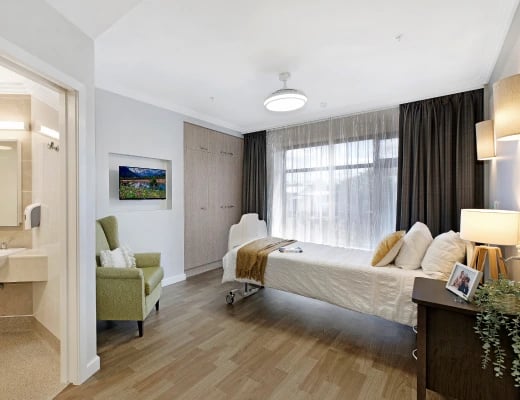Specialised dementia care home design
Our homes are designed to evidence-based standards that are proven to improve your quality of life.

Homes that support the whole person
When you're living with dementia, being in a purpose-designed care home can be life-changing.
Drawing on internationally-recognised design principles, HammondCare's homes are expertly designed to help you make choices for yourself, supporting you to stay as independent as possible.
While reducing the impact of physical, cognitive and sensory disabilities, good building design supports you to feel at home by prioritising your comfort, familiarity, and sense of belonging.

Designed to improve your quality of life
Real home environment
HammondCare's cottages reflect the recommendations of the Royal Commission and are designed to promote normality in everyday life. This means having the flexibility to do what you want, when you want.
Living in a small household, each person is treated as an individual and supported to build strong, trusting relationships with their care team.
Familiar, homely kitchens
Through style and layout, HammondCare's homes help people know where they are, and see where they are going next.
Domestic kitchens are situated at the heart of the cottages, and have appliances you can recognise and use.
This provides familiarity and comfort through the sights, smells, and sounds of cooking.
Clever, gentle design
Subtle features like paint colours and carpet patterns can help a person living with dementia to feel at ease.
HammondCare's cottages combine soothing colours with lots of natural light to promote a sense of calm.
The cottages are also designed so the line of sight from each area helps with navigating easily around the home.
Normal sights and sounds
Seeing or hearing unfamiliar things in your own home can be unsettling - this effect is amplified for someone living with dementia. HammondCare's cottages are designed so the sights and sounds people experience resemble what is experienced in a normal home.
The safety features are unobtrusive, and utility rooms and clinical equipment is concealed to enhance the sense of home.
Flexibility in daily life
HammondCare doesn't have fixed activity schedules, mealtimes are flexible, and family and friends are welcome to visit at any time.
The cottages have a mix of shared living areas and quiet places to sit and relax, so residents can choose when to socialise with others or enjoy time to yourself.
Meaning and purpose
Everyone has the right to feel a sense of meaning and purpose in daily life.
HammondCare's cottages support specialised carers to create positive and inclusive environments where each person can participate.
For instance, there are accessible features such as regular washing machines, tumble dryers, and clotheslines, so residents can keep being part of normal daily activities.
Personalised care
Care works best when it's tailored to the individual - both through the care team's approach and the physical environment.
At HammondCare, people are encouraged to personalise their room with their favourite furniture, artwork, and keepsakes, so it feels even more like home. This includes decorating a mounted memory box at the entry to the bedroom.

Contact us
We'd love to welcome you. If you have any questions about our accommodation or services, please call us on 1800 998 111 or send a message.

